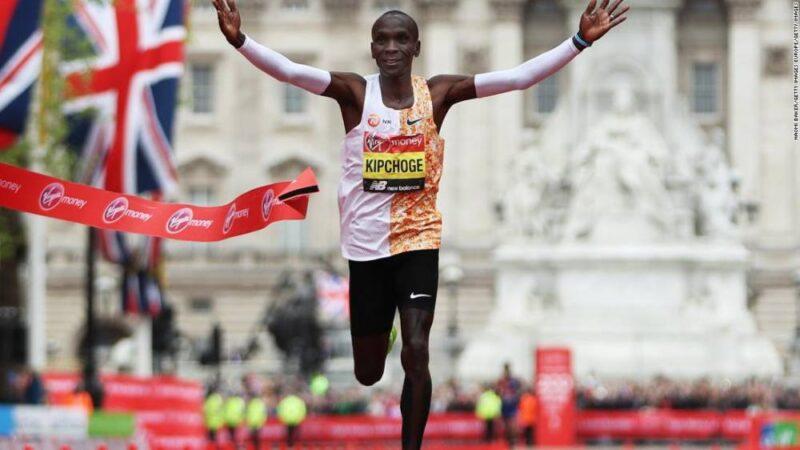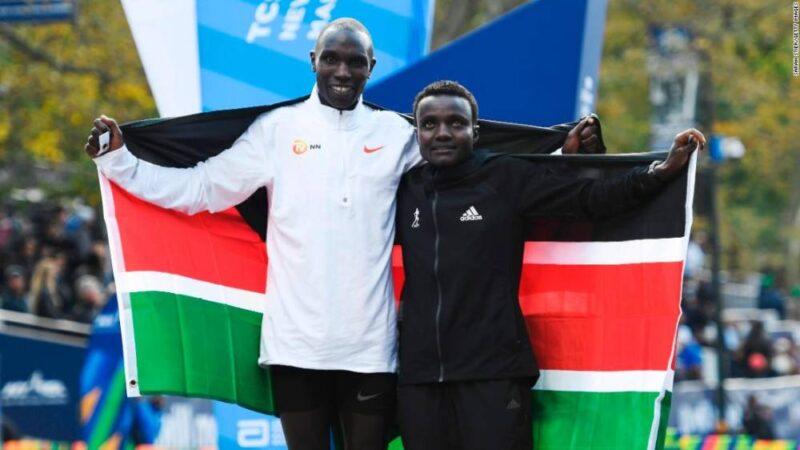Nairobi, Kenya (CNN)Last month, Eliud Kipchoge finished a marathon in 1 hour, 59 minutes and 40 seconds — an audacious feat that no one had ever accomplished before. Kipchoge is from the Kenyan Rift Valley region.
A day after he made history, Brigid Kosgei destroyed the women’s world record at the Chicago Marathon. She’s also from the Kenyan Rift Valley. And in the New York Marathon on Sunday, a Kenyan rookie took down her country’s rock star in the women’s race. Joyciline Jepkosgei ruined countrywoman Mary Keitany’s chance at a fifth women’s title in the contest, but the latter came in second. And Kenyan Geoffrey Kamworor won the men’s race, his second NYC Marathon victory.
They’re all from the Rift Valley region. And people are taking note — marathoners from all over the world go there to train before major races.

Eliud Kipchoge crosses the finish line during the London Marathon East Africans — especially Kenyans and Ethiopians — have dominated marathons for decades, dashing across finish lines as their exhausted competitors barely made it. In the process, they’ve toppled their own records or those of their fellow citizens.Read MoreKenyan marathon runners are such a phenomenon that research organizations have done studies on why they dominate long distance races.And experts say it’s mixture of several things.

Mary Keitany (front left) trains her husband and coach Charles Koech (front right) in Iten, Kenya.
Most of the elite runners are from the same region
Most Kenyan elite runners hail from the same ethnic groups known as the Kalenjins and the Nandis. The groups make up just 10% of the nation’s population of 50 million — but bring in a majority of the nation’s marathon medals. “Internationally, Kalenjin runners have won close to 73% of all Kenyan gold medals and a similar percentage of silver medals at major international running competitions,” says Vincent O. Onywera, a professor of exercise and sports science at Kenyatta University in Nairobi. They’ve passed on the passion for running across generations, turning the Rift Valley — especially the small town of Iten — into a mecca for the nation’s elite long distance runners. There, children start running at a young age. A lot of the young people from these areas grow up surrounded by successful runners. Most of them look at running as a way to make money, says coach Bernard Ouma, who trains elite Kenyan runners. “You see your neighbor run and win, it motivates you to run and win,” he says. As a result, their communities have a deep tradition of running excellence built over the years.
They train and live in a high-altitude area
Most of the Kenyan runners who dominate marathons worldwide train and live in the high-altitude Rift Valley.Iten, one of the towns that produces elite runners, sits nearly 8,000 feet above sea level in western Kenya. Training at high altitudes contributes to a running dominance that makes running at lower elevation child’s play, Onywera says. “There is a widespread belief in the athletic community that altitude training can enhance sea level athletic performance, with at least three independent studies demonstrating that altitude training increases both sea level maximal oxygen consumption and running performance,” he says.

Geoffrey Kamworor and Joyciline Jepkosgei pose with the Kenyan flag after the New York Marathon.
Then there’s diet and constant motivation
Iten has become known internationally as the place where long distance champions are made. So much so, runners from around the world go there to train before major races. Running aficionado and author Adharanand Finn spent a lot of time in the town trying to find out the secret to Kenyan marathon runners. “I had a lifelong fascination with the uninhibited running style of the Kenyans and had always wanted to know the story behind their incredible athletes — I wanted to know what their lives were like. And when I saw there was no book, or at that time no films, on the subject, I decided to go there and write one.”His book, “Running with the Kenyans,” gives more insight into what he found out. And there is no one major secret, he says. “As the famed coach of David Rudisha, Brother Colm O’Connell, says, the only secret is that there’s no secret. It’s not one thing but a perfect storm of elements that come together in Kenya’s Rift Valley region to make the people there so strong at distance running,” Finn says.There’s the location, the way of life, the environment. “For a start, you have the altitude, the tough rural upbringing and the fact that children run around everywhere. Then there is the simple diet, the lack of junk food, and the perfect running terrain — rolling hills, dirt roads — all over the place,” he says. And if that doesn’t lure you in, there’s the proximity to international elite runners to motivate anyone. “Running offers a great chance to make good money, to transform lives, even to transform whole communities,” Finn says. “This is compounded by the hundreds of role models everywhere. Almost every village has someone who has come back from ‘abroad’ with winnings, and these stars are very accessible and open to supporting the younger athletes.”As a result, everyone who can run, aspires to be a runner, he says.”You end up with thousands of people training together, pushing each other, helping each other, inspiring each other. This attracts agents, sponsors, coaches … and it keeps getting bigger. With all this impetus, some great athletes are going to emerge out the other end,” he says. “So really, it’s not a simple answer.”

Mary Keitany
Some have wondered whether genes play a role
There’s so much speculation on why Kenyans and Ethiopians keep crushing marathon competitions, the phenomenon has long been a subject of study. Organizations such as the British Journal of Sports Medicine have concluded that it’s unclear whether genes have anything to do with it.
“The periodic domination of middle and long distance running by different regions of the world is not a new phenomenon,” it says. “Researchers are yet to confirm a genetic or physiological advantage in being a middle or long distance runner of East African origin, and it is most likely that the reasons for their success are many.”And while many physiological and anatomical factors have been suggested to explain the East African dominance, research has not revealed any definitive advantage, the study says.
Source: edition.cnn.com

